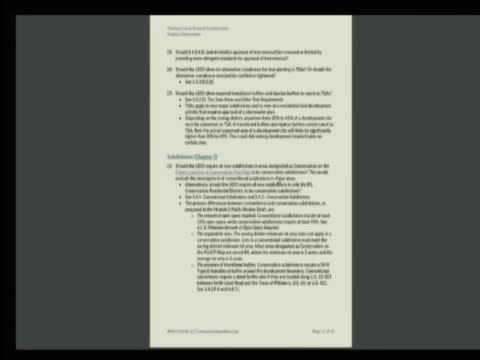Tree preservation plan sparks debate over development incentives
July 15, 2024 | Chatham County, North Carolina

This article was created by AI summarizing key points discussed. AI makes mistakes, so for full details and context, please refer to the video of the full meeting. Please report any errors so we can fix them. Report an error »

In a recent government meeting, officials discussed proposed changes to the Unified Development Ordinance (UDO) regarding tree preservation and development incentives. The primary focus was on whether to allow reductions in the total amount of Tree Save Areas (TSA) as an incentive for developers to preserve significant trees. The consensus leaned towards permitting these reductions, particularly when the preserved areas contain preferred tree specimens, which could enhance the rural character of neighborhoods.
The discussion highlighted the need for a balanced approach to development, where increased density is often countered by concerns over septic systems and site features. The proposed incentive structure aims to encourage the preservation of established trees, particularly hardwoods in riparian zones, which serve as vital wildlife corridors.
Another key point of contention was the ability to remove trees within designated TSA if necessary for site development. Current proposals suggest that while trees can be removed, they must be replanted elsewhere on the property. This provision raised concerns among planning board members and tree protection advocates, who fear it may lead to the loss of valuable specimens.
The meeting also touched on the concept of alternative compliance for planting standards, particularly in challenging environments like wetlands. While some members expressed support for flexibility in planting requirements, others cautioned against allowing non-native plant communities, emphasizing the importance of preserving the region's natural forest ecosystem.
Lastly, the discussion included the treatment of transitional and riparian buffers as separate from TSAs, with the aim of maximizing habitat preservation. The planning board acknowledged that while these buffers could significantly increase the area designated for tree preservation, careful consideration is needed to balance development needs with environmental conservation.
Overall, the meeting underscored the ongoing efforts to refine development regulations to promote sustainable practices while accommodating growth.
The discussion highlighted the need for a balanced approach to development, where increased density is often countered by concerns over septic systems and site features. The proposed incentive structure aims to encourage the preservation of established trees, particularly hardwoods in riparian zones, which serve as vital wildlife corridors.
Another key point of contention was the ability to remove trees within designated TSA if necessary for site development. Current proposals suggest that while trees can be removed, they must be replanted elsewhere on the property. This provision raised concerns among planning board members and tree protection advocates, who fear it may lead to the loss of valuable specimens.
The meeting also touched on the concept of alternative compliance for planting standards, particularly in challenging environments like wetlands. While some members expressed support for flexibility in planting requirements, others cautioned against allowing non-native plant communities, emphasizing the importance of preserving the region's natural forest ecosystem.
Lastly, the discussion included the treatment of transitional and riparian buffers as separate from TSAs, with the aim of maximizing habitat preservation. The planning board acknowledged that while these buffers could significantly increase the area designated for tree preservation, careful consideration is needed to balance development needs with environmental conservation.
Overall, the meeting underscored the ongoing efforts to refine development regulations to promote sustainable practices while accommodating growth.
View full meeting
This article is based on a recent meeting—watch the full video and explore the complete transcript for deeper insights into the discussion.
View full meeting
